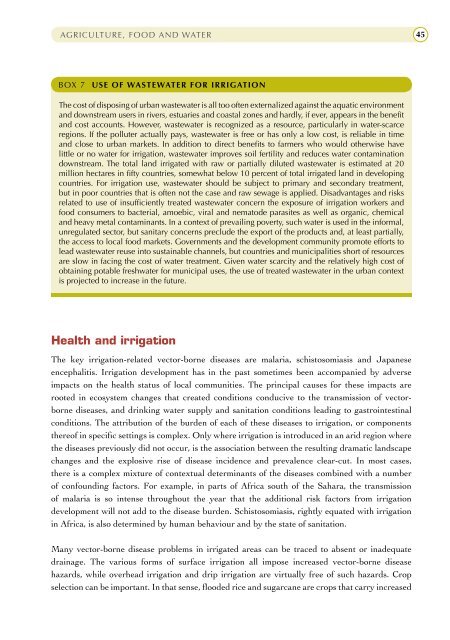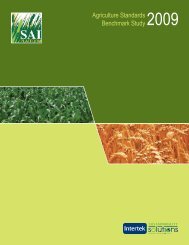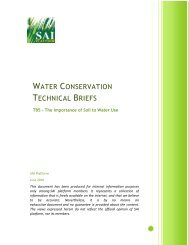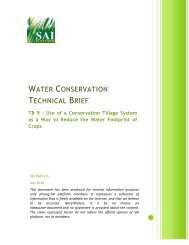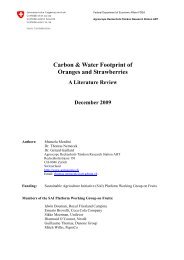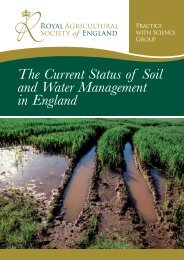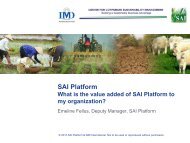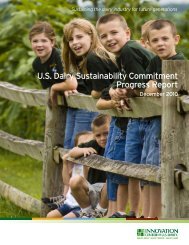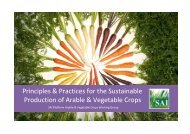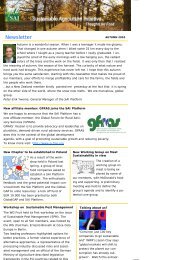Agriculture, food and water - FAO.org
Agriculture, food and water - FAO.org
Agriculture, food and water - FAO.org
You also want an ePaper? Increase the reach of your titles
YUMPU automatically turns print PDFs into web optimized ePapers that Google loves.
AGRICULTURE, FOOD AND WATER<br />
45<br />
BOX 7 USE OF WASTEWATER FOR IRRIGATION<br />
The cost of disposing of urban waste<strong>water</strong> is all too often externalized against the aquatic environment<br />
<strong>and</strong> downstream users in rivers, estuaries <strong>and</strong> coastal zones <strong>and</strong> hardly, if ever, appears in the benefit<br />
<strong>and</strong> cost accounts. However, waste<strong>water</strong> is recognized as a resource, particularly in <strong>water</strong>-scarce<br />
regions. If the polluter actually pays, waste<strong>water</strong> is free or has only a low cost, is reliable in time<br />
<strong>and</strong> close to urban markets. In addition to direct benefits to farmers who would otherwise have<br />
little or no <strong>water</strong> for irrigation, waste<strong>water</strong> improves soil fertility <strong>and</strong> reduces <strong>water</strong> contamination<br />
downstream. The total l<strong>and</strong> irrigated with raw or partially diluted waste<strong>water</strong> is estimated at 20<br />
million hectares in fifty countries, somewhat below 10 percent of total irrigated l<strong>and</strong> in developing<br />
countries. For irrigation use, waste<strong>water</strong> should be subject to primary <strong>and</strong> secondary treatment,<br />
but in poor countries that is often not the case <strong>and</strong> raw sewage is applied. Disadvantages <strong>and</strong> risks<br />
related to use of insufficiently treated waste<strong>water</strong> concern the exposure of irrigation workers <strong>and</strong><br />
<strong>food</strong> consumers to bacterial, amoebic, viral <strong>and</strong> nematode parasites as well as <strong>org</strong>anic, chemical<br />
<strong>and</strong> heavy metal contaminants. In a context of prevailing poverty, such <strong>water</strong> is used in the informal,<br />
unregulated sector, but sanitary concerns preclude the export of the products <strong>and</strong>, at least partially,<br />
the access to local <strong>food</strong> markets. Governments <strong>and</strong> the development community promote efforts to<br />
lead waste<strong>water</strong> reuse into sustainable channels, but countries <strong>and</strong> municipalities short of resources<br />
are slow in facing the cost of <strong>water</strong> treatment. Given <strong>water</strong> scarcity <strong>and</strong> the relatively high cost of<br />
obtaining potable fresh<strong>water</strong> for municipal uses, the use of treated waste<strong>water</strong> in the urban context<br />
is projected to increase in the future.<br />
Health <strong>and</strong> irrigation<br />
The key irrigation-related vector-borne diseases are malaria, schistosomiasis <strong>and</strong> Japanese<br />
encephalitis. Irrigation development has in the past sometimes been accompanied by adverse<br />
impacts on the health status of local communities. The principal causes for these impacts are<br />
rooted in ecosystem changes that created conditions conducive to the transmission of vectorborne<br />
diseases, <strong>and</strong> drinking <strong>water</strong> supply <strong>and</strong> sanitation conditions leading to gastrointestinal<br />
conditions. The attribution of the burden of each of these diseases to irrigation, or components<br />
thereof in specific settings is complex. Only where irrigation is introduced in an arid region where<br />
the diseases previously did not occur, is the association between the resulting dramatic l<strong>and</strong>scape<br />
changes <strong>and</strong> the explosive rise of disease incidence <strong>and</strong> prevalence clear-cut. In most cases,<br />
there is a complex mixture of contextual determinants of the diseases combined with a number<br />
of confounding factors. For example, in parts of Africa south of the Sahara, the transmission<br />
of malaria is so intense throughout the year that the additional risk factors from irrigation<br />
development will not add to the disease burden. Schistosomiasis, rightly equated with irrigation<br />
in Africa, is also determined by human behaviour <strong>and</strong> by the state of sanitation.<br />
Many vector-borne disease problems in irrigated areas can be traced to absent or inadequate<br />
drainage. The various forms of surface irrigation all impose increased vector-borne disease<br />
hazards, while overhead irrigation <strong>and</strong> drip irrigation are virtually free of such hazards. Crop<br />
selection can be important. In that sense, flooded rice <strong>and</strong> sugarcane are crops that carry increased


